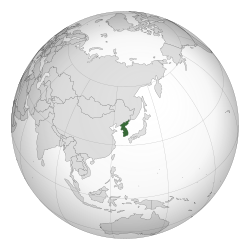Joseon
Korean dynasty (1392–1897) From Wikipedia, the free encyclopedia
Joseon (Hangul: 조선; Hanja: 朝鮮; also Chosŏn, Choson, Chosun, Cho-sen), was a Korean state started by Taejo Yi Seong-gye. It began after the end of the Goryeo Dynasty at what is today the city of Kaesong. It ended with the assassination of Empress Myeongseong. Joseon was the last dynasty of Korean history and the longest Confucian dynasty.
Joseon | |||||||||
|---|---|---|---|---|---|---|---|---|---|
| 1392–1897 | |||||||||
 Territory of Joseon after Jurchen conquest of King Sejong | |||||||||
| Capital | Hanseong[a] | ||||||||
| Common languages | Korean | ||||||||
| Common script | Classical Chinese, Korean | ||||||||
| Religion | Confucianism (state ideology) Buddhism Shamanism Taoism Christianity (recognized in 1886) | ||||||||
| Government | Absolute monarchy[2] | ||||||||
| King | |||||||||
• 1392–1398 (first) | Taejo | ||||||||
• 1863–1897 (last) | Gojong | ||||||||
| Yeonguijeong, later Prime Minister[b] | |||||||||
• 1392–1398 (first) | Jeong Do-jeon | ||||||||
• 1896–1898 (last) | Yun Yong Seon | ||||||||
| History | |||||||||
• Coronation of Taejo | 5 August 1392 | ||||||||
• Creation of the Korean alphabet | 9 October 1446 | ||||||||
• Japanese invasions | 1592–1598 | ||||||||
• First and second Manchu invasions | 1627, 1636–1637 | ||||||||
• Japan–Korea Treaty of 1876 | 26 February 1876 | ||||||||
| 17 April 1895 | |||||||||
| 13 October 1897 | |||||||||
| Population | |||||||||
• 1400[3] | 5,730,000 | ||||||||
• 1500[4] | 9,000,000 | ||||||||
• 1600[4] | 11,000,000 | ||||||||
• 1700[4] | 13,500,000 | ||||||||
• 1900[3] | 17,082,000 | ||||||||
| Currency | Mun (1423–1425, 1625–1892) Yang (1892–1897) | ||||||||
| |||||||||
| Today part of | North Korea South Korea | ||||||||
| Korean name | |
| Hangul | |
|---|---|
| Hanja | |
| Revised Romanization | Joseon |
| McCune–Reischauer | Chosŏn |
| IPA | [tɕo.sʌn] |
| North Korea name | |
| Hangul | |
| Hanja | |
| Revised Romanization | Joseon Bonggeon Wangjo |
| McCune–Reischauer | Chosŏn Bonggŏnwangjo |
| Official name | |
| Hangul | |
| Hanja | |
| Revised Romanization | Daejoseonguk |
| McCune–Reischauer | Taechosŏnguk |
| IPA | [tɛ.tɕo.sʌn.ɡuk̚] |
Today, some Koreans use the word "Joseon" to mean something bad because they think of the Joseon Dynasty as something that failed. Young Koreans use the expression "Hell Joseon" to talk about how hard it is to find a good job in South Korea today.[7]
History
Major events
The creation of Hangul[8]
Hangul is the language of Korea that is still used today.
Hangul was created by King Sejong the Great in 1443 and officially put into effect nationwide in 1446. It was created based on the shape of the human vocal apparatus when pronouncing it.[9] The creation of Hangul had many good influences, including the creation of culture.
Japanese Invasion (Imjin War)
The Japanese Invasion was a war between Joseon and Japan from 1592 to 1598 (7 years). Toyotomi Hideyoshi of Japan invaded Joseon after unifying his country. Then king, Seonjo, fled to the north. But as the Joseon's army, including Yi Sun-sin, fought hard, Japan retreated for a while. Japan invaded again in 1597,[10] and the war ended when Toyotomi Hideyoshi died.
During the war, many cultural assets of Joseon were destroyed and taken away.[11]
Qing invasion
The Qing invasion was a war fought between the Joseon Dynasty and the Qing Dynasty from 1636 to 1637. Joseon fought to protect the country, but Joseon was eventually defeated by the Qing Dynasty. Injo surrendered to the Qing Dynasty.
At this time, many Qing soldiers kidnapped Joseon women to make concubine or sell them.[12] Including this, a lot of social damage had occurred to Joseon because of this invasion.
Notes
- Now Seoul, South Korea.
References
Wikiwand - on
Seamless Wikipedia browsing. On steroids.




